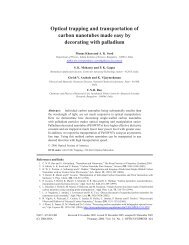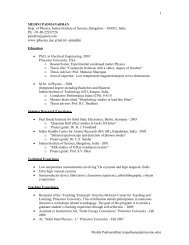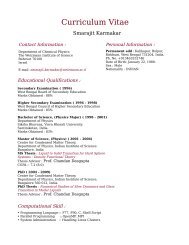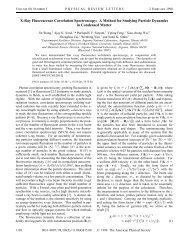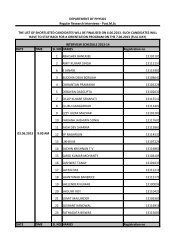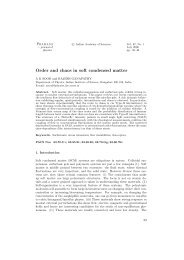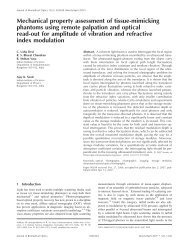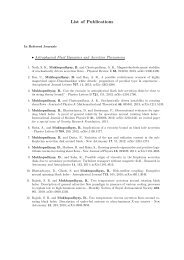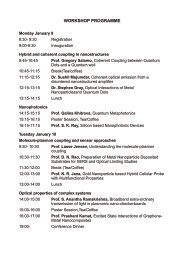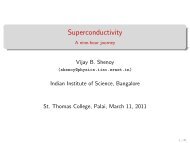Hydrodynamic Fluctuations and Instabilities in Ordered ... - Physics
Hydrodynamic Fluctuations and Instabilities in Ordered ... - Physics
Hydrodynamic Fluctuations and Instabilities in Ordered ... - Physics
You also want an ePaper? Increase the reach of your titles
YUMPU automatically turns print PDFs into web optimized ePapers that Google loves.
VOLUME 89, NUMBER 5 PHYSICAL REVIEW LETTERS 29JULY 2002<br />
under z ! z, i.e., by sett<strong>in</strong>g v 0 1 0. This can<br />
readily be shown to yield the dispersion, ! 2<br />
Aq 2 cos2 2 cos2 1 , where jAj w 0 . Physically,<br />
this can be understood as follows. The nematic symmetry<br />
z ! z means that a distortion with wave vector at exactly<br />
45 has no wavelike response: it does not know which way<br />
to go, so the O q 2 contribution to the squared frequency<br />
! 2 q vanishes at this angle. ! 2 must thus change sign as<br />
crosses 45 .For =4 , where is small <strong>and</strong> has<br />
the p same sign as A, we thus get an <strong>in</strong>stability with ! q<br />
i j j q iq 2 . Here the last term appears when diffusive<br />
<strong>and</strong> viscous terms <strong>and</strong> the conventional nematic-elastic<br />
torques are <strong>in</strong>cluded, <strong>and</strong> will stabilize modes at larger<br />
wave number. For an SPP nematic on a substrate as <strong>in</strong> [12],<br />
a wave-number-<strong>in</strong>dependent damp<strong>in</strong>g enters the momentum<br />
Eq. (5) <strong>and</strong> <strong>in</strong> general suppresses this <strong>in</strong>stability [20].<br />
<strong>Fluctuations</strong>: In strik<strong>in</strong>g contrast to systems at thermal<br />
equilibrium, ordered suspensions of SPPs display giant<br />
number fluctuations. To see this, we must <strong>in</strong>clude noise,<br />
as well as the damp<strong>in</strong>g terms whose form we have discussed,<br />
<strong>in</strong> the equations of motion. For a general SPP<br />
suspension one expects noise sources of three k<strong>in</strong>ds: thermal<br />
Brownian motion (negligible for particles larger than a<br />
few microns), many-particle hydrodynamic <strong>in</strong>teractions,<br />
<strong>and</strong> <strong>in</strong>tr<strong>in</strong>sic fluctuations <strong>in</strong> the self-propell<strong>in</strong>g activity of<br />
<strong>in</strong>dividual SPPs. In our coarse-gra<strong>in</strong>ed description it is<br />
reasonable to assume Gaussian noise sources f u , f c , <strong>and</strong><br />
f n , delta correlated <strong>in</strong> time, <strong>in</strong> the equations of motion for<br />
u, c, <strong>and</strong> n. Momentum <strong>and</strong> number conservation imply<br />
variances q 2 for f u <strong>and</strong> f c for wave number q ! 0, <strong>and</strong><br />
nonzero for f n . With these noise <strong>and</strong> damp<strong>in</strong>g terms <strong>in</strong><br />
place we can calculate correlation functions of the various<br />
fields <strong>in</strong> theRsteady state. We f<strong>in</strong>d that the structure factor<br />
S q c0<br />
1<br />
r exp iq rh c 0 c r i 1=q2 , which implies<br />
that the variance of the number of particles, scaled by<br />
the mean, grows as L 2 N 2=3 for a three-dimensional<br />
region of l<strong>in</strong>ear size L conta<strong>in</strong><strong>in</strong>g N particles on average.<br />
Physically, this happens because distortions <strong>in</strong> the director<br />
produce mass flow. S<strong>in</strong>ce the director fluctuations—a<br />
broken-symmetry mode—are large, this results <strong>in</strong> giant<br />
number fluctuations as well. Similar supernormal number<br />
variances were predicted [6,8,9] for SPPs on a substrate; it<br />
is remarkable that they survive here <strong>in</strong> the presence of<br />
long-ranged hydrodynamic <strong>in</strong>teractions.<br />
Let us now estimate the numerical values of the effects<br />
we predict. All wave speeds are expected to be of order the<br />
drift speed of an SPP (from m=s to cm=s as one goes<br />
from bacteria to fish). If we take the k<strong>in</strong>ematic viscosity<br />
to be that of water, then the growth rate of the convectively<br />
unstable mode <strong>in</strong> Stokesian polar-ordered SPP suspensions,<br />
say, for bacteria (where velocities are 10 m=s,<br />
size a m, <strong>and</strong> a few percent), is 0:1 s 1 . We look<br />
forward to experimental tests of our predictions, on liv<strong>in</strong>g<br />
organisms or perhaps on artificial SPP suspensions.<br />
An analysis of the complete (not l<strong>in</strong>earized) equations of<br />
motion, now underway, will show how nonl<strong>in</strong>ear fluctuation<br />
effects renormalize the speeds <strong>and</strong> damp<strong>in</strong>gs of the<br />
modes presented here, <strong>and</strong> whether they alter the manner <strong>in</strong><br />
which number fluctuations diverge with size. The full<br />
equations of motion will also prove useful <strong>in</strong> underst<strong>and</strong><strong>in</strong>g<br />
the effect of imposed shear flows on the state of order<br />
of SPP suspensions, <strong>and</strong> the role of boundaries [21]<br />
<strong>and</strong> topological defects <strong>in</strong> these systems. These, as well<br />
as other results on SPP nematics on substrates <strong>and</strong> an<br />
analysis of isotropic SPP suspensions [3], will appear elsewhere<br />
[20].<br />
S. R. thanks the Aspen Center for <strong>Physics</strong> for support<br />
while part of this work was done.<br />
*Electronic address: aditi@physics. iisc.ernet.<strong>in</strong><br />
† Electronic address: sriram@physics.iisc.ernet.<strong>in</strong><br />
[1] J. Lighthill, SIAM Rev. 18, 161 (1976).<br />
[2] T. J. Pedley <strong>and</strong> J. O. Kessler, Annu. Rev. Fluid Mech. 24,<br />
313 (1992).<br />
[3] X.-L. Wu <strong>and</strong> A. Libchaber, Phys. Rev. Lett. 84, 3017<br />
(2000); G. Grégoire, H. Chaté, <strong>and</strong> Y. Tu, Phys. Rev. E 64,<br />
011902 (2001).<br />
[4] C. Reynolds, Comput. Graph. 21, 25 (1987); J.<br />
Deneubourg <strong>and</strong> S. Goss, Ethol. Ecol. Evolution 1, 29<br />
(1989); A. Huth <strong>and</strong> C. Wissel, <strong>in</strong> Biological Motion,<br />
edited by W. Alt <strong>and</strong> E. Hoffmann (Spr<strong>in</strong>ger-Verlag,<br />
New York, 1990); B. L. Partridge, Sci. Am. 246, No. 6,<br />
114 (1982).<br />
[5] T. Vicsek, A. Czirók, E. Ben-Jacob, I. Cohen, <strong>and</strong><br />
O. Shochet, Phys. Rev. Lett. 75, 1226 (1995).<br />
[6] J. Toner <strong>and</strong> Y. Tu, Phys. Rev. Lett. 75, 4326 (1995).<br />
[7] N. Shimoyama, K. Sugawara, T. Mizuguchi, Y. Hayakawa,<br />
<strong>and</strong> M. Sano, Phys. Rev. Lett. 76, 3870 (1996).<br />
[8] J. Toner <strong>and</strong> Y. Tu, Phys. Rev. Lett. 80, 4819 (1998).<br />
[9] J. Toner <strong>and</strong> Y. Tu, Phys. Rev. E 58, 4828 (1998).<br />
[10] P. C. Mart<strong>in</strong>, O. Parodi, <strong>and</strong> P. S. Pershan, Phys. Rev. A 6,<br />
2401 (1972); D. Forster, <strong>Hydrodynamic</strong> <strong>Fluctuations</strong>,<br />
Broken Symmetry, <strong>and</strong> Correlation Functions (Benjam<strong>in</strong>,<br />
Read<strong>in</strong>g, 1975).<br />
[11] Reference [9] suggests that crystall<strong>in</strong>e, translational order<br />
may be seen <strong>in</strong> flocks as well.<br />
[12] H. Gruler, U. Dewald, <strong>and</strong> M. Eberhardt, Eur. Phys. J. B<br />
11, 187 (1999); R. Kemkemer, D. Kl<strong>in</strong>g, D. Kaufmann,<br />
<strong>and</strong> H. Gruler, Eur. Phys. J. E 1, 215 (2000).<br />
[13] H. Gruler, M. Schienbe<strong>in</strong>, K. Franke, <strong>and</strong> A. deBoisfleury-<br />
Chevance, Mol. Cryst. Liq. Cryst. 260, 565 (1995).<br />
[14] P. G. de Gennes <strong>and</strong> J. Prost, The <strong>Physics</strong> of Liquid<br />
Crystals (Clarendon Press, Oxford, 1995).<br />
[15] We ignore heat diffusion, nutrient uptake, excretion, reproduction,<br />
<strong>and</strong> death.<br />
[16] As <strong>in</strong> [6,8,9], the speed of advection is not <strong>in</strong> general equal<br />
to the drift speed, hence the factor 1.<br />
[17] D. Forster, Phys. Rev. Lett. 32, 1161 (1974).<br />
[18] Such terms are ruled out <strong>in</strong> equilibrium nematics by the<br />
requirement that force densities arise from a free-energy<br />
functional via Poisson-bracket relations.<br />
[19] See J.-B. Manneville, P. Bassereau, S. Ramaswamy, <strong>and</strong><br />
J. Prost, Phys. Rev. E 64, 021908 (2001).<br />
[20] R. A. Simha <strong>and</strong> S. Ramaswamy (to be published).<br />
[21] Y. Tu, Physica (Amsterdam) 281A, 30–40 (2000).<br />
058101-4 058101-4



